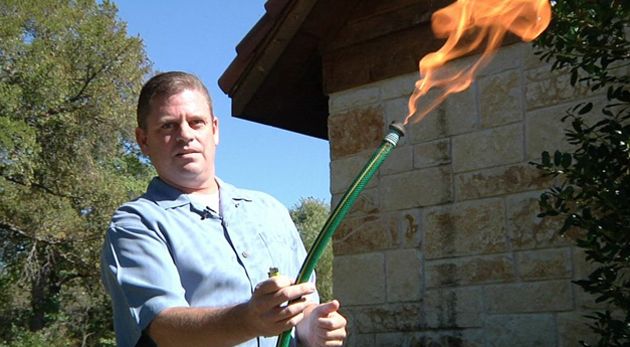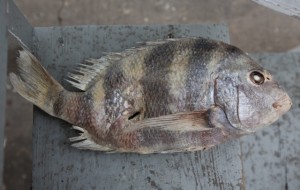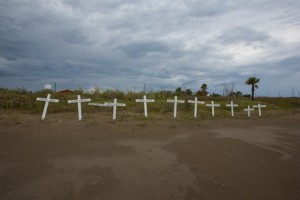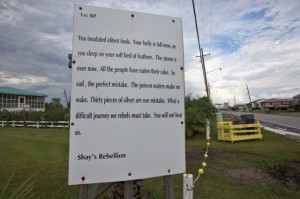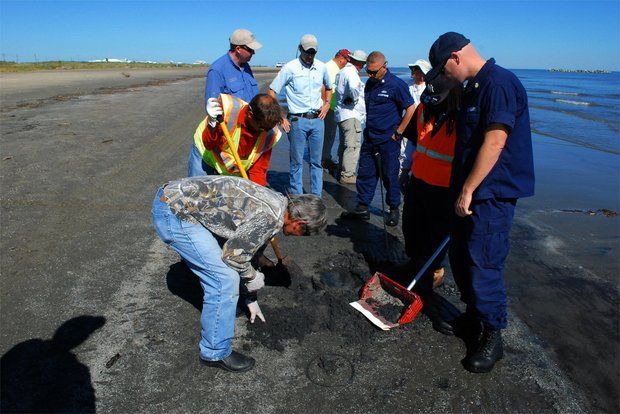http://insideclimatenews.org/news/20131016/behind-russia-vs-greenpeace-furor-unreported-oil-pollution-arctic
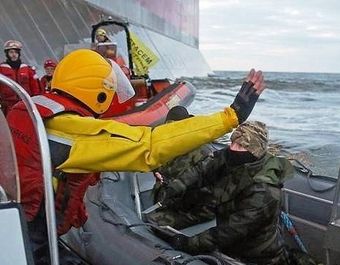
About 4 million barrels of spilled oil, as much as BP’s Gulf of Mexico spill, is flowing into the Arctic Ocean every year, Greenpeace says.
By Zahra Hirji, InsideClimate News
Oct 16, 2013
A Russian Coast guard officer points a knife at a Greenpeace activist as protesters attempt to climb the Prirazlomnaya oil platform in the Arctic Ocean’s Pechora Sea. Credit: Greenpeace
Like
An environmental organization with a $350 million war chest, a giant protest vessel, 28 activists and a rubber raft have succeeded in drawing Russian President Vladimir V. Putin into a very public global dispute.
Attention is now focused on the Greenpeace activists-who were arrested last month by Coast Guard agents for trying to hang a protest banner on an Arctic Ocean oil platform-and whether they will languish in prison for up to 15 years each on dubious piracy charges.
“They are obviously not pirates,” Putin said in a speech to the International Arctic Forum last month. Yet Russian authorities so far seem to be throwing the book at the activists as international outrage grows to secure their freedom. Protests have been held at Russian consulates in about a half dozen cities worldwide to release the activists.
While the unfolding drama is now focused on issues of civil disobedience and human rights, underneath the uproar is a tangle of issues around Arctic drilling that Greenpeace has been campaigning to address for many years. And now it has secured the world’s attention and a chance to spark a discussion-and the stakes are high.
Earlier this year in a report called Point of No Return, the confrontational organization identified oil drilling in Arctic waters as one of the biggest climate threats being ignored by the world’s governments.
“Oil companies plan to take advantage of melting sea ice … to produce up to 8 million barrels a day of oil and gas,” Greenpeace said in the report. “The drilling would add 520 million tons of CO2 a year to global emissions by 2020.”
That Greenpeace would target Russia’s Prirazlomnoye oil platform-which this fall is expected be the world’s first offshore Arctic well-should not come as a surprise. And it is equally unsurprising that Russia, currently the world’s biggest oil producer, would react so sharply to protect its oil interests and the flagship project of its multibillion-dollar quest to drill, especially as the United States is overtaking Russia as the No. 1 energy producer.
“This is probably the strongest reaction we’ve gotten from a government since the French government blew up one of our ships [in 1985 in an anti-nuclear protest],” said Philip Radford, executive director of Greenpeace USA.
Hidden from view so far, however, has been the environmental damage the Arctic is already suffering at the hands of the Russian oil industry, a degradation that would likely get worse if the oil boom there continues without better regulation, according to Greenpeace and other Russian environmentalists and scientists.
Every year, according to Greenpeace, about 30 million barrels of oil products leak from wells and pipelines in Russia. An estimated four million barrels of that, roughly the size of BP’s Gulf of Mexico spill, flows straight into the Arctic Ocean through tributaries.
The precise impact of these spills on the fragile Arctic environment and its people is unknown but is likely substantial, Greenpeace says. For them the leaks-and the alleged lack of adequate means to deal with them-are an example of an inadequate safety culture in the country’s oil industry. And they’re causing deep concern about Russia’s aggressive push to start drilling for oil in open Arctic waters.
“Russia will not be ready for effective monitoring, supervising and working in the Arctic Ocean,” said Vladimir Chuprov, a Russian citizen and the head of energy for Greenpeace Russia in Moscow, the country’s main energy industry watchdog. Chuprov has been monitoring oil spills for the past decade.
Poor Record
While Russia produces 12 percent of the world’s oil, it is responsible for roughly half the world’s oil spills, according to Greenpeace Russia figures. Broken down, the numbers reveal that some 30 million barrels of petroleum leak from 20,000 inland spills each year.
Official government records paint a different picture. Russian environmental officials say there are only hundreds of inland spills a year. Among other omissions, however, those figures don’t include spills that dump less than 56 barrels, because companies aren’t required to report those incidents.
The two Russian oil companies that already received government approval to drill the Arctic have notorious records for oil accidents and spills.
The Prirazlomnoye platform in the Arctic’s Pechora Sea that Greenpeace targeted is owned and operated by Gazprom Neft Shelf LLC, a subsidiary of the state-run energy giant OAO Gazprom. Gazprom Neft was responsible for the country’s worst offshore oil disaster in December 2011, when a floating rig sank in the Sea of Okhotsk, killing 53 workers.
According to the company’s 2012 sustainability report, the company reported 2,626 pipeline ruptures that year and 3,257 ruptures in 2011.
Gazprom has landed several other licenses to build exploratory drilling wells and platforms in a half dozen other Russian Arctic seas.
Rosneft, another major state-run oil company and the country’s biggest oil producer, has also secured licenses and is expected to begin drilling its first well in early 2014.
Last year, Rosneft was named Russia’s worst environmental polluter by the regional paper Bellona after a government report found that the company had 2,727 reported spills in 2011 in a single northwestern province.
In an interview with InsideClimate News, Vladimir Antoshchenko, a Gazprom Neft Shelf spokesperson, said the Prirazlomnoye project was “based on strict demands on environmental and industrial safety.” He said the rig has Arctic-specific ice-crushing machines to blast floating icebergs and special boats to safely navigate the icy waters.
Alexey Knizhnikov, an environmental policy officer based in the Moscow office of the World Wildlife Fund, said he “has not seen any effective technology to combat an oil spill in ice conditions.”
Either way, environmentalists and other critics of Russia’s Arctic energy plans say there are deeper reasons why the country’s oil industry isn’t ready for Arctic drilling.
It wasn’t until the early 1990s, after the collapse of the Soviet Union, that substantial environmental regulations for energy companies were introduced in Russia. The end of Communism brought the establishment of environmental advocacy in the country, which, among other factors, led to the roll out of more and better rules, such as financial penalties for oil spills, but they’re not enough.
For decades the government has been harshly criticized for concealing petroleum spills from the public and the media, levying meager fines that hardly discourage violators, and for failing to require companies to have adequate emergency response plans and spill response tools, among other criticisms.
Valentina Semyashkina, former chair of the Save the Pechora Committee, an environmental organization that works in the Arctic Komi Republic told InsideClimate News that “concealment of accidental oil spills” by energy companies is a regular occurrence. So is the government’s “turning a blind eye,” she said.
The Komi Republic, a province the size of Germany with a largely indigenous population, has been on the frontlines of Russia’s oil rush for years. Accidents have been prevalent, including a vast spill of as much as 2 million barrels from a corroded pipeline in 1994. The incident was first made public by a U.S. Department of Energy official who revealed the spill to the New York Times, prompting accusations of a Russian government cover-up.
“The power is always on the side of big businesses and never on the side of the citizens,” Semyashkina said.
She pointed to a recent oil spill in the Komi Republic. In late May this year, a local Komi resident on his way to work spotted a big blob of black gooey oil in the area’s Kolva River from a pipeline that tore apart in the early winter months. The pipeline’s operator, the Russian- and Vietnamese-owned company Rusvietpetro, had detected the rupture in November but nothing happened.
More than a dozen community members ran the cleanup, shoveling oil into barrels and putting them on the shore before the government emergency response officials arrived and took over about a week later. By late June, Rusvietpetro had repaired the line, which it said broke due to a drop in pressure in the line. The government response ended on July 25, after 3,500 barrels of oil spilled out.
A resident helps clean up the Kolva River oil spill/Credit: Greenpeace
The oil is still threatening the fish and cows that the local indigenous Komi people depend on to earn their living, according to Semyashkina. And several residents are still cleaning up the mess without compensation.
Rusvietpetro didn’t respond to requests for comment.
Local authorities say some of the oil and oil products have reached the Pechora River, a tributary of the Arctic Ocean, as is typical following spills in the Russian tundra, the country’s biggest oil-producing area, Greenpeace’s Chuprov said.
Arctic Challenges
About 13 percent of the planet’s undiscovered oil and 30 percent of its natural gas lie under Arctic land and water, most of it offshore, according to projections.
One-third of that oil and more than half of the gas is buried on and off Russia’s coastline. And for the first time, the trove of energy is accessible to drilling, a result of both global warming-which has turned the northern ice cap into mush in the summer months-and advanced drilling technology.
Drilling for oil and gas in the Arctic Ocean poses new and difficult challenges for industry, and this is particularly worrying for conservation advocates who oppose Russia’s advance into the Arctic.
“We saw how hard it was to respond to the serious offshore drilling incident in the Gulf of Mexico with the Deepwater Horizon spill,” said Doug Norlen, director for Pacific Environment, an advocacy and research organization that supports a moratorium on Arctic drilling. Now imagine a spill in the Arctic, where “you are dealing with places that are far away from response capabilities. … It’s a recipe for a disaster.”
Although drilling conditions vary across the ocean’s 5.4 million square miles, the risk of a blowout and a catastrophic spill are threatening all over. Fast-developing storms can wield hurricane-force winds. Icebergs up to a mile in length drift across its choppy currents.
Water temperatures typically hover well below zero. If an accident were to occur in countries lacking emergency response infrastructure along their Arctic coastlines-as in Russia-it could take emergency response crews several hours to arrive at the site under the best conditions and perhaps days.
Marilyn Heiman, director of the U.S. Arctic program at the Pew Charitable Trusts, said that to respond to spills immediately all countries bordering icy Arctic waters would need emergency response centers that are located within a few hundred miles of a drilling site.
These centers would have to be manned by response workers 24 hours a day, because once oil enters the sea, the dark slime can be carried to distant shorelines via strong ocean currents or sink to the depths of the ocean floor.
No country with icy waters has a center this close. In Alaska, the nearest Coast Guard response unit is around 1,000 miles from planned Arctic drilling locations. (It is unclear whether U.S. Arctic drilling regulations, to be released later this year, will require closer emergency centers at planned U.S. drilling sites.)
Knizhnikov of the environmental organization WWF said he’s skeptical that adequate centers will be built in Russia. “It will be very difficult to become reality because [the centers are] very costly,” he said. “It will take many, many years before they will be created, if they will be created.”
Companies in Control
Still, on July 1, Russia passed stricter safety standards and pollution cleanup regulations for offshore drillers than it has in place for inland operations.
Russia now requires companies to have more and better equipment to collect spilled oil-such as booms and skims on hand at all times at drilling sites. The rules also require companies to react to spills faster. According to Russian law, drilling operators must respond to spills at sea within four hours of discovering them, whereas companies have six hours to respond to spills on land.
Most experts say the regulations are not sufficient to address serious concerns about a major spill in the Arctic, one of Earth’s last pristine wilderness areas. For instance, regulations dictating the type of safety equipment and spill response operators must use are too general to be effective, many say.
Even those experts who say Russia’s rules are adequate have their worries.
“The regulations are good,” said Alexei Bambulyak, a Russian environment expert at the Norwegian environment research institution Akvaplan-niva. However, “whether they are followed or not is up to the [drilling] operators.”
The five counries with major Arctic claims-Canada, Denmark, Iceland, Norway, Russia and the United States-are moving somewhat slower than Russia, either because of uncertain energy prospects or environmental security and safety concerns.
Norway is the exception, but it has the world’s most stringent standards for offshore drilling safety and is drilling in warmer waters than Russia with less sea ice. In 2007, Norway’s Statoil became the first driller in the world to produce natural gas in Arctic waters.
According to Eric Haalan, a spokesperson for Statoil, Arctic drillers everywhere have “absolutely everything to lose” by working in the Arctic Ocean unprepared.
“Meaning, if we don’t do it properly, we lose more than anyone else. And we have seen the consequences of accidents that have happened in the past, and what effect that has had on even large companies,” he said.
Extreme Consequences
Greenpeace has a long history of taking a strong stand against Arctic drilling and other issues and accepting the consequences, according to Radford, the Greenpeace USA executive director.
“But the consequences by Russia are unbelievably extreme and illegal and unjust,” he said.
Twenty-eight Greenpeace activists and two journalists from 18 countries are sitting in prison and facing charges of piracy, which carries a sentence of up to 15 years in prison. Two of the activists tried to scale the tower on the Gazprom Neft platform before the Russian Coast Guard fired 11 warning shots into the water near their raft and ordered them to come down. They descended before they were able to hang a banner and were immediately arrested. The Coast Guard waited a day before raiding the Arctic Sunrise protest ship, where the other activists were located.
This week Russia denied bail to the U.S. captain of a Greenpeace ship and another activist.
The harsh reaction reflects Russia’s new urgency to tap its Arctic resource. Almost exactly one year ago, six Greenpeace protestors climbed the same Arctic platform and hung a banner, and the Coast Guard did nothing. In fact, oil company crew members reportedly gave them soup.
Radford said he hopes people see that the arrested Greenpeace activists were acting for the benefit of the world.
“They were doing this to alert the world of the first ever offshore deep Arctic well drilling that could cause radical climate change and could cause a huge oil spill that the [Russian] Coast Guard thinks is their nightmare scenario,” Radford said. “Now, that wasn’t for private gain, that was for the benefit of all of us.”
Special thanks to Richard Charter
